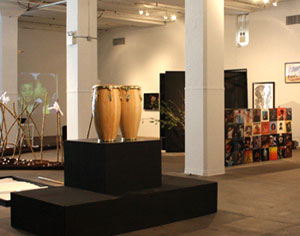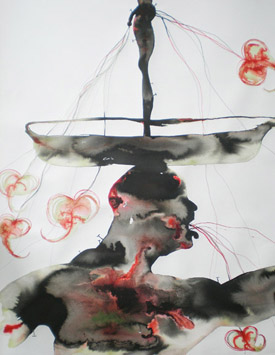In and Out of Africa
John Haberin New York City
Négritude and Bathélémy Toguo
Strikingly, at least three shows in as many months have looked at blackness and tried to see beyond America's borders. "Négritude" at Exit Art connects cotton plantations, the slave trade, and jazz in New York, all by way of Paris in the 1930s. A black star at its center, pointing in all directions, looks beyond any one place or history all by itself. "Signs Taken for Wonders" in Chelsea focused on Africa, but for portraits lost in a crowd, in silhouette, or in tribal magic.
For an American, race has a corrosive history—but a distinctly national history. Exit Art looks just as much to Haiti and Africa, for a nexus of plantation culture, the slave trade, and indigenous art. At the Studio Museum, Thelma Golden has called for a post-black art. One might instead call "Négritude" post-African American. Its five curators come from at least three continents. Exit Art is nearly a continent to itself anyway. 
Each had something to offer. However, each also shows how slowly things change. Decades after "primitivism" in modern art and the civil-rights movement, it is still hard to see Africa apart from western eyes and America's racial trauma. If Obama's teachable moment on race is coming, it had better last more than a moment and come soon.
That makes the third show especially welcome. The sole exhibition of a black African, Bathélémy Toguo, it moves between Paris and Cameroon. He finds the same western eyes staring at him in both.
Post-African American
Already in the 1930s, the label negro carried plenty of baggage. Aimé Césaire—a poet, playwright, and politician from Martinique—wished to reclaim it for black intellectuals. The movement spread through Paris and beyond after World War I. It found support from a future Senegalese president and Jean-Paul Sartre. Exit Art, too, seeks "portraits of colonialism and freedom." In appropriating a confusion of past stories for present-day identity, it also follows plenty of contemporary art.
In practice, "Négritude" quickly devolves into Exit Art's familiar low-key sprawl, but at least it has the good grace to leave out Jean-Michel Basquiat. If it seems more focused than usual, however, it has a black five-pointed star at its center. Papo Colo, Exit Art's co-founder, has made an "island" of live cotton, peat moss, and sugar plants, like cotton skies for John Dowell. He invites one to write one's name in raw sugar and to fold stacked posters of "icons of Négritude" into paper boats. (Not to worry: they come with instructions.)
For Greg Tate's "mini-exhibition," Xaviera Simmons and Arthur Jafa set out LP covers, a drum kit, and a raised stand awaiting performance. They blend easily into paintings by Purvis Young, Thornton Dial, and Lonnie Holley. Laminated book pages lean against the base of Bessie Harvey's Giacometti-like running man. Tate calls the clutter an anti-panopticon. He refers to a notorious English prison with all-seeing jailors, described by Michel Foucault as a parable of western civilization. It could just as well belong in a jazz and art fan's apartment—or in Tate's longtime music criticism.
Tânia Cypriano's segment looks more like untitled film stills. Her documentary evidence includes a Brazilian documentary film festival, with photographs by Mario Cravo Neto. Conversely, in turning to older imagery, Rose Réjouis might be offering contemporary rituals. From France via the New School, she chooses Wura-Natasha Ogunji, Andre Justé, Vladimir Cybil, and Charlier Justé. The first weaves thread into paper outlines of women. The latter three arrange paper towels into scrolls.
The whole show has a participatory flavor, light on actual history, politics, or even fine art. The largely white perspective on Africa in "Signs Taken for Wonders" seems downright polemical by comparison. More white puffs bury François Ziliff's neon sign announcing change. It puns on cotton exchange, but mostly it adds to the glow of Tenth Avenue toward sunset. In his curatorial segment, Franklin Sirmans, too, returns to New York in spirit as well as practice. He selects Tierney Malone's paintings, the illusion of walls cut by the grid of worn posters.
Sirmans, of Houston's Menil Collection, has passed this way before. Just months ago, he curated "NeoHooDoo" at P.S. 1. There he celebrated the marriage of art, continents, cultures, and rituals—of "Art for a Forgotten Faith." At the same time, many of the artists showed the violent breakdown of traditional practices. In much the same way, Tate refers here to "Black Mystery." He could be describing instead a loss of black history.
The use of wondering
"Signs Taken for Wonders" sounds in search of magic. The curator, Isolde Brielmaier, has in mind images of Africa far from the documentary clarity of David Goldblatt or Zwelethu Mthethwa, and she leaves open just who has taken them for wonders. Who, for that matter, has taken them to speak for Africa? Do the artists, of mixed color and nationality, add up to a continent or just the gallery's summer group show? At their best, though, they present nothing more or less miraculous than ordinary faces. More often than not, when they look at a continent, they see people.
Often the faces mime another emblem of Africa, masks. Julien Friedler sculpts faces in glass and sets them on pillars like totems. He seems very much to aspire to myth—but a myth filtered through European decorative arts. He styles himself the "Spirit of Boz" collective, based in so many countries that Africa becomes almost incidental. Gallery-goers can participate, with a poll on such deep questions as the existence of God. More often, though, the masks take their humanity from photographs and their impersonality from popular culture.
Jeffrey Gibson lets eyes, from digital prints, peek out of painted abstractions. They give his decorative style more kick, and they would have no trouble with one question in Boz's poll: is sexuality important? Jean-Ulrick Désert turns faces into a patchwork of blank areas. Désert sticks to a couple of high-profile figures in global politics, including Kofi Annan and Angelina Jolie, and the blankness comes from a pretence of color by numbers. The device is deliberately repetitive, like the tabloid celebrity it shunts, but it looks for miracles in the real world.
 Other artists put a human face on politics. Xaviera Simmons enlarges grainy prints of crowded boats, carrying mostly women into exile. One remembers individuals facing forward, each with a separate fate. Carrie Mae Weems hangs her photo album haphazardly in a corner. The monochrome portraits in shades of gray, pink, or blue will not turn into an icon. I did not catch onto the theme of Africa for several minutes, and I found that a provocative response to modern myths of the primitive.
Other artists put a human face on politics. Xaviera Simmons enlarges grainy prints of crowded boats, carrying mostly women into exile. One remembers individuals facing forward, each with a separate fate. Carrie Mae Weems hangs her photo album haphazardly in a corner. The monochrome portraits in shades of gray, pink, or blue will not turn into an icon. I did not catch onto the theme of Africa for several minutes, and I found that a provocative response to modern myths of the primitive.
Once I did catch on, the faces started to vanish, and the show's impact diminished. Its title, an echo of Western culture and in the passive voice, wants things both ways. It promises wonders, and it promises to see past the wonders to the signs. It promises the miracle of other lives, and it promises not to reduce others to a stereotype of "the other." It does not take either promise all that seriously—and anyway Boz was the pen name for a European writer, Charles Dickens. Still, it has a place for faces in an increasingly global culture.
The one work about place tries the hardest to have it both ways. Kader Attia photographs African architecture of poured concrete. Local idioms, he argues, influenced Le Corbusier, and history has repressed their memory. He also argues that Brutalism, as a European import, has brutalized local idioms. This would work better as a book, and anyway Le Corbusier discovered his materials long before he discovered Africa. These dwellings, too, would come alive with the faces of a continent.
Going bananas
Bathélémy Toguo may have the most cheerful show about racism, exile, and AIDS ever. (Just wait till a museum tackles New York art in 1993.) Of course, he does not have much competition, not even from Wangechi Mutu. Still, he takes pleasure even in his own displacement.
Born in Cameroon in 1967, Toguo has a studio in Paris, and he has not forgotten the status of an immigrant. That must be him on video, in hard hat, endlessly pushing a pipe down the street. Fortunately, it appears made of foam rubber. That must be him, too, bloodied from a homemade attempt at circumcision. Unlike far too many Africans, at least he has lowered his risk of AIDS. His videos remain short, as if churned out just for fun, but also just a little too long for comfort.
If he never forgets his status or his homeland, others will not let him forget. Photographs paired with text describe different kinds of displacement, from African borders to exclusion in Europe. Authorities order the speaker off a train, because his safety vest might scare other passengers. Others take "systematic pleasure" in searching his luggage. The photos could document a whole cast of exiles—or stages in one long, determined work of performance art. Toguo takes systematic pleasure in it all, too.
More luggage piles up in the back room, its floor paved with Chiquita Banana cartons. Mounds of clothing on brightly decorated cots look halfway human. They go literally over the top. They could be the scene of refugees or excessive pleasure, and the actual subject bears on both. The installation title, The AIDS Issue Cannot Be Resolved Thanks to the Distribution of Condoms, sounds in denial. But look again, and the title is in quotes, with an attribution to the pope.
However, the bulk of the show consists of large watercolors. They may depict birds, serpents, skeletons, totems, or jesters. They may be spitting blood or ingesting guns and, yes, bananas. From their blacks and reds, the artist might have painted in blood and water. It makes sense that they could all pass for playing cards or Rorschach tests. They could be playing with or testing his idea of Africa—or the viewer's.
Toguo may be having too much fun for his own good. With its four media, "Pregnant Mountain" could easily pass for a group show. Its size and pace have a lot in common with breathless displays of emerging artists, like "Younger Than Jesus" this spring at the New Museum. At least he also conveys the fun to others. In the end, too many recent shows, from Exit Art and the New Museum to Marlene Dumas, have viewed Africa without letting its subjects speak for themselves—not unlike Modernism's long fascination with African art. Now a black African artist does speak, and he jokes about his own outrage.

"Négritude" ran at Exit Art through July 25, 2009, "Signs Taken for Wonders" at Jack Shainman through July 3, and Bathélémy Toguo at Robert Miller through October 29.




